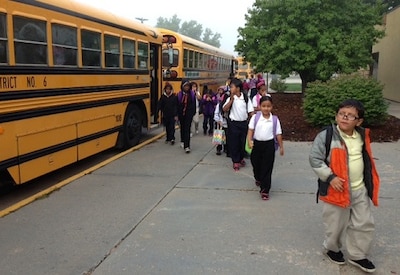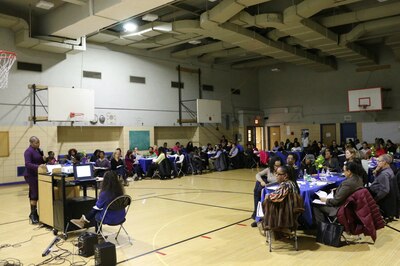The flood waters that deluged northern Colorado last month left more than a dozen school districts hustling to provide basic services to thousands of students newly-designated as homeless.
That means help with transportation to and from school even if students are now living far from their home schools or in other districts. It means free lunches, new school clothes, new backpacks, and fee waivers for things like after-school care or full-day kindergarten.

While administrators are happy to help their flood-ravaged families get back on track, and community donations and volunteer efforts have eased the pain, the sudden surge in students legally classified as homeless is both overwhelming and costly.
In Weld County School District 6, where 800 students are newly homeless, the district has been spending about $1,000 a day to transport displaced students from temporary quarters to their home schools, in some cases sending buses far afield to pick up students doubled up with relatives or staying in hotels. Under a federal law called the McKinney-Vento Homeless Assistance Act, school districts are required to provide students classified as homeless with the services they need to stay in school.
“We are just treading water,” said Theresa Myers, the district’s director of communications. “We are scrambling to find the money.”
While districts are using their reserves, McKinney-Vento grants or other resources to pay the bills right now, additional help will soon arrive in the form of a $750,000 federal grant that state education officials were notified about earlier this week. Called Project SERV, for School Emergency Response to Violence, the grant program is meant to help school districts restore the learning environment after violence or disaster.
“I am so enormously excited about it,” said Trish Boland, who will coordinate the grant process for the Colorado Department of Education.
She said the money, which could start arriving in late November, will reimburse affected districts for expenses such as transportation for homeless students, overtime incurred by staff helping with flood relief and mental health services for students experiencing anxiety or other symptoms in the flood’s aftermath.
While about 30 districts are eligible for Project SERV funds, Boland said administrators from a few less-severely affected districts have already offered to defer their chance at the money so that harder-hit districts can get more.
Rising homeless numbers
According to Colorado Department of Education estimates, up to 4,000 students in 14 districts could be classified as homeless because their homes were destroyed or damaged by the floods or made inaccessible because of road closures.
While Weld 6 will likely post the biggest numbers, other districts have seen huge numbers as well, often double or triple what they would normally see this time of year. In St. Vrain Valley schools, nearly 300 of the district’s 445 homeless students have been so designated because of the flooding. In Boulder Valley schools, it’s 175 of 413; in Thompson, it’s 75 of about 200; and in the 3,400-student Johnstown-Milliken district, it’s 28 of 33.
The recent flooding is by no means the only natural disaster to create a sudden bump in students classified as homeless, but it certainly represents a worst case scenario.
“The magnitude of the flood has been greater,” said Dana Scott, state coordinator for the education of homeless children and youth at CDE.
To compare, three recent wildfires — the Waldo Canyon and High Park fires in June 2012 and the Black Forest Fire in June 2013 — made around 250 students in three districts eligible for homeless services under the McKinney-Vento Act, according to ballpark estimates from the Colorado Department of Education.
While a homeless designation under McKinney-Vento can make students eligible for an array of services from their districts, it can be a jarring term for parents, one that conjures up images of sleeping in cardboard boxes on the street. Many families don’t equate staying temporarily with a relative or staying in their own home without water or electricity with homelessness, but both qualify under the law.
Some district staff working with newly-designated homeless families have opted to use the word “displaced” instead of homeless, hoping to take the sting out of their official classification.
“It’s less catastrophic,” said Boland.
Because of the sheer numbers of impacted families and the need to spread the word quickly about the little-known McKinney-Vento law, several districts trained teachers, campus monitors or other staff to identify and connect with students eligible for homeless services. In addition, staff from the Colorado Department of Education and homeless liaisons from several unaffected districts volunteered to travel north and help out.
Jana Ramchander, homeless liaison for the Thompson School District, said of impacted families, “They are just in shock. A lot of them are not aware of the resources available to them.”
The transportation maze
For district transportation directors, the past few weeks have been a daily scramble to track down and transport flood-impacted students, many of whom are still moving around.
“I have families moving from campground to campground,” said Ramchander.

Under McKinney-Vento, districts must ensure that students can get to and from school, but the “how” is flexible. It can include traditional busing, taxis, passes for city transit and mileage reimbursement for parents who can drive their kids. With yellow buses often the first choice, transportation staff have adjusted existing routes, created new ones, partnered with neighboring districts and combined students at different school levels on the same bus.
“To get them to school is a challenge,” said Myers. “To get them to school on time is another challenge.”
In Weld 6, where buses are already stretched thin with additional runs, some teachers have volunteered to transport displaced students to and from school. In Loveland, the Thompson School District is using its Chevy Suburban fleet to shuttle some homeless students.
In St. Vrain, the district is providing gas money to some families who must travel long distances in their own vehicles to get their kids to school. One such family is commuting to their Longmont school from temporary quarters in south Denver.
“They really want to stay attached to their school,” said Luis Chavez, the district’s homeless liaison. “They’re doing everything possible.”
A pop-up school
One of the goals of the McKinney-Vento Act is to ensure that students experiencing housing crises don’t miss much, if any school. Toward that end, officials in the St. Vrain Valley district hastily created a new school for 700 students who normally attend Lyons Elementary School and Lyons Middle/Senior High, which are still without water and power.
“Those families wanted to stay together,” said Regina Renaldi, the district’s assistant superintendent of priority programs. “The community has just rallied like I can’t even believe.”
District staff repurposed Main Street School in downtown Longmont for the Lyons students, some of whom are classified as homeless and some of whom are not. Special education programs were moved out of the building to other sites and district staff drove trucks to the two out-of-commission schools to gather furnishings, supplies and even the contents of kids’ lockers.
While roads to the elementary school were passable, the district had to obtain permission from a family to drive through their property to get to the middle/senior high school because a bridge was out.
Meeting needs, bracing for the long haul
Besides getting students to and from school, administrators and volunteers in flood-impacted districts have worked hard to ensure that newly homeless students have food, clothes and school supplies. To start, many children were immediately signed up for free school meals, which under the law, doesn’t require the usual income verification paperwork.
In Weld 6, three schools started providing free dinners to flood-impacted families starting Monday. In the Thompson district, Ramchander said the Rotary Club is providing backpacks filled with weekend food provisions to send home with students through its Kid Pack program.

In one fortunate coincidence, a semi-truck loaded with 2,200 new backpacks and school supplies from “Feed the Children” happened to be heading to Colorado during the driving rains the precipitated the flood. Although the backpacks were not specifically intended for flood victims, once the magnitude of the disaster became clear, the distribution plan changed.
“We reworked some of the numbers so we had more backpacks go up north,” said Scott.
While many district officials are quick to praise staff and community helpers for generous donations and tireless efforts since the floods, it may be a long haul for some families. In Weld 6, the district is gearing up for the next big need among homeless students: warm clothing.
In St. Vrain Valley, many families remain worried about the safety of their water-logged homes.
“One of the biggest problems they’re dealing with right now is the debris and the mold…It’s a time bomb,” said Chavez. “They feel like they’re going to start getting ill.”
